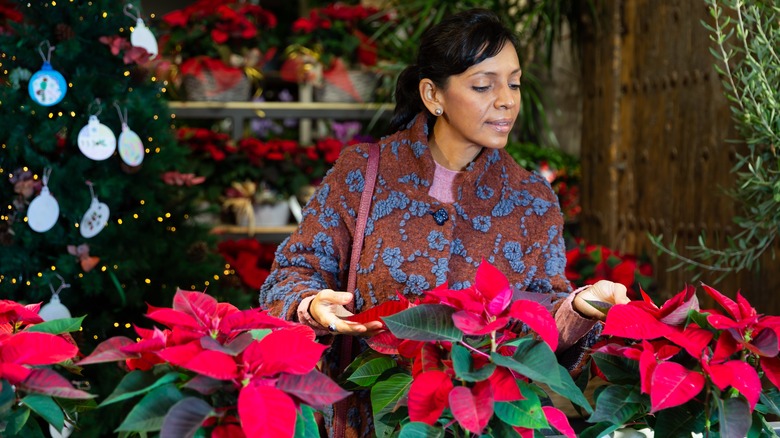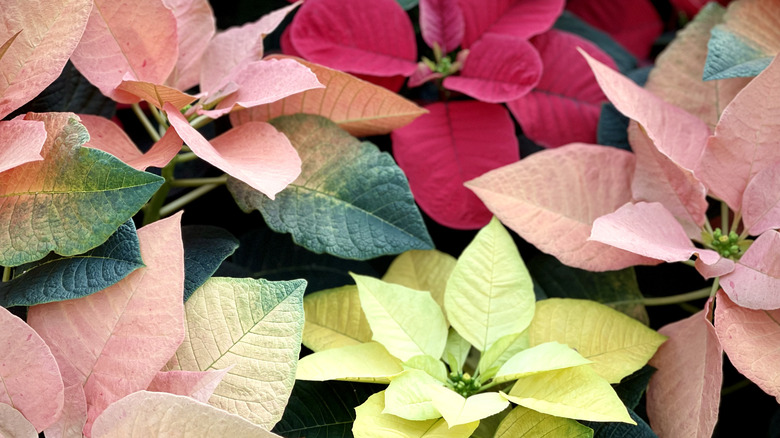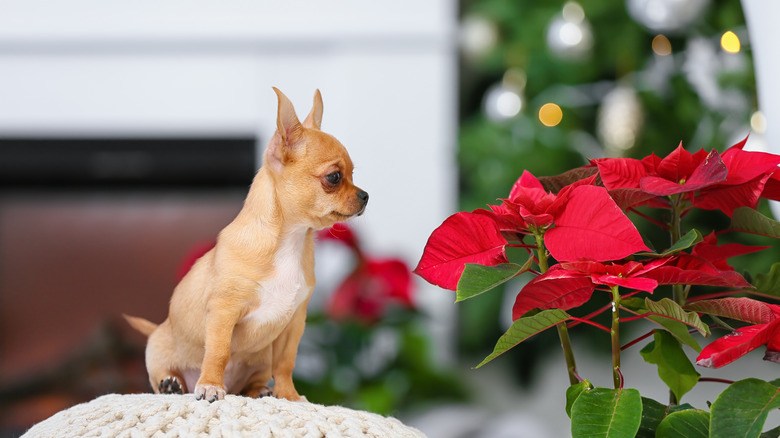This Is The Ideal Temperature For A Poinsettia
Home improvement stores and nurseries are bursting with Christmas décor, including large displays of colorful poinsettias. While their presence seems significant among the seasonal cheer, these holiday essentials are also comforting and expected. Like a loaf of bread or mints from the grocery checkout stand, they're the one item you likely didn't go shopping for but invariably leave with.
In fact, poinsettias (Euphorbia pulcherrima) are the top-selling potted plant in the country, according to the University of Illinois. There are more than 100 varieties of poinsettias, which are also called the flame-leaf and lobster flower, aptly named for their vibrant red color. However, they're also available in pink, white, yellow, salmon, burgundy, and purple. Interestingly, their signature pointed and velvety petals aren't flowers but rather specialized leaves (known as bracts) surrounding the true flowers; purchase those with the least amount of yellow pollen for increased plant longevity.
Poinsettias serving as holiday décor go back a half-millennium, and for many of us, the season wouldn't be the same without them. Per Florgeous, they became a symbol of Christmas in 16th-century Mexico and Guatemala, their native habitat where they grow freely. Their modern meaning also comprises success, joy, and celebration — the reason for their popularity as gifts. Whether you've gifted a poinsettia or a few to yourself (the more the merrier) or received one in good cheer, there are some best care practices to ensure they brighten these shorter days for as long as possible.
Poinsettia care
According to the University of Illinois, the gorgeous range of poinsettia hues is created by depriving the plants of light to achieve a specified color. To keep it vivid, place the plant where it will receive indirect light for at least six hours per day. While a window sill seems like an ideal spot, don't allow the leaves and bracts to come into contact with cold panes of glass.
Further, poinsettias aren't very tolerant of warm or cool drafts, so avoid putting them in areas near heating vents, radiators, fireplaces, and windows and doors with air leaks. Temperatures between 60 and 70 degrees during the day and approximately 55 degrees at night are optimal; if feasible, it's recommended to relocate them somewhere cool overnight. However, the University of Minnesota cautions that temperatures below 50 degrees can damage plants.
Potted poinsettias prefer well-drained, moist soil, so be careful neither to allow them to sit in standing water nor become dry enough to wilt. After the holidays — and as new growth begins to develop — fertilize them every few weeks.
Appealing poinsettia displays
According to Web MD, although the myth of poinsettias' extreme toxicity has been widely debunked, they do possess a sap that can cause skin irritation. In addition, you may experience vomiting and nausea if you ingest the leaves, but it won't be life-threatening; their unappealing taste makes it rather unlikely. Regardless, in a home with young children and pets, it's a good idea to keep them out of reach where they can be feasted on with eyes alone.
There are some wonderful ways to use poinsettias to spread the festive spirit. HGTV says a faux (and draftless) fireplace is a perfect spot for a large plant; conceal the dark firebox behind fiery red flowers. If safety is of concern, adorn the mantle with a few small pots instead. Alternately, craft a beautiful dining room centerpiece. Go simple with a large and spectacular plant in a decorative pot, combine them with other appropriate greenery into a towering bouquet, or vary several sizes, employing a cake stand as a central riser to create a tabletop poinsettia tree.
Ornament unexpected places around the house with a splash of color, such as a bathroom counter or guest bedroom side table. And, for the most magnificent array, don't forget to reward your poinsettias with the gift of proper care.


